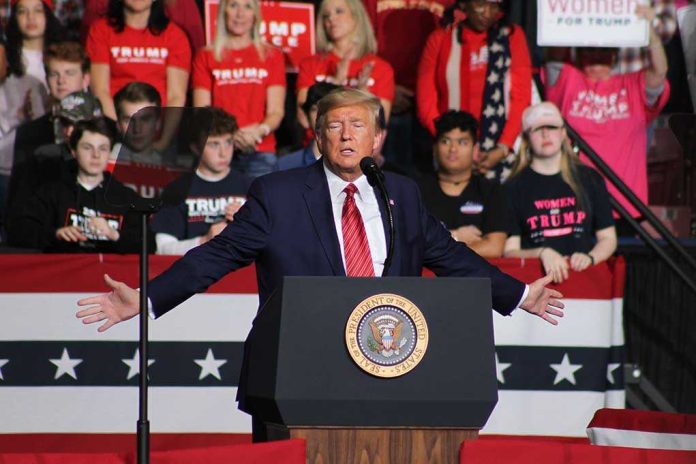
President Trump’s Supreme Court bid to regain control over federal regulatory agencies could fundamentally restructure the balance of power in Washington and strip away decades of entrenched bureaucratic independence.
Key Takeaways
- President Trump has appealed to the Supreme Court to allow the firing of three Biden-appointed Consumer Product Safety Commission members.
- A federal judge in Maryland ruled Trump’s removal of the commissioners unlawful, a decision later upheld by the 4th Circuit Court of Appeals.
- Federal law currently restricts presidential authority to remove commissioners except for “neglect of duty or malfeasance.”
- This case represents the third recent Supreme Court appeal involving presidential power to remove executive officers.
- The outcome could significantly impact the independence of federal regulatory agencies and expand presidential authority.
Presidential Authority Challenge Reaches Supreme Court
The Trump administration has taken its battle for greater control over independent federal agencies to the Supreme Court, requesting permission to dismiss three members of the Consumer Product Safety Commission (CPSC). This move comes after President Trump attempted to remove commissioners Mary Boyle, Alexander Hoehn-Saric, and Richard Trumka Jr., all appointed by the previous administration with terms set to expire in 2023, 2027, and 2028, respectively. The legal confrontation centers on fundamental questions about presidential power and the autonomy of federal regulatory bodies.
The commissioners challenged their removal, resulting in a federal judge’s decision to reinstate them, ruling that President Trump’s actions violated federal law. Current statutes only permit removing commissioners for specific causes such as neglect of duty or malfeasance, not at presidential discretion. The U.S. Court of Appeals for the 4th Circuit subsequently upheld this decision, prompting the administration to file an emergency appeal with the Supreme Court, marking the third recent case involving presidential authority to remove executive officers.
Constitutional Powers at Stake
Solicitor General D. John Sauer, representing the administration, has argued that the district court’s order fundamentally undermines the president’s constitutional powers. The administration’s position contends that Article II of the Constitution grants the president authority to remove executive branch officials, including those serving on independent commissions. This perspective challenges decades of precedent regarding the structure and independence of regulatory agencies, which were designed with statutory protections to shield them from political pressure and ensure consistent policy implementation across changing administrations.
The Consumer Product Safety Commission wields significant regulatory power, responsible for setting safety standards for consumer products, ordering recalls of dangerous items, and bringing civil suits against companies that violate safety regulations. These responsibilities affect countless American businesses and consumers, making the commission’s independence—or lack thereof—a matter of substantial public importance. The administration’s legal strategy builds upon previous Supreme Court victories that expanded presidential removal powers over other independent agency officials.
Broader Implications for Federal Regulatory Structure
This case extends beyond the immediate question of three commissioners’ employment status to potentially reshape the relationship between the presidency and the administrative state. If successful, President Trump’s legal challenge could grant this and future administrations unprecedented control over regulatory bodies that Congress intentionally structured to operate with a degree of independence. Conservative advocates for constitutional originalism have long argued that such independence conflicts with the president’s role as chief executive, while critics contend that independent agencies provide necessary stability and expertise in complex regulatory areas.
The commissioners’ legal team has opposed the request for swift Supreme Court action, arguing there is no demonstrable harm from allowing them to continue serving in their positions while the case proceeds through normal judicial channels. They maintain that Congress deliberately created statutory protections for commission members specifically to prevent politically-motivated removals. The outcome of this case could either reinforce those protections or significantly diminish them, with far-reaching consequences for regulatory policy and presidential power.
Historical Context and Future Implications
The Supreme Court has previously sided with President Trump in similar cases involving federal independent labor boards, allowing removal of members without cause despite statutory protections. These precedents suggest a judicial trend toward expanding presidential authority over the administrative state. A decision in the administration’s favor would align with conservative legal philosophy that questions the constitutionality of independent agencies that operate outside direct presidential control. Such agencies have been fixtures of the federal government since the Progressive Era, with their independence traditionally justified as necessary for technical expertise and policy continuity.
The timing of this case places it at the intersection of ongoing debates about executive power, regulatory policy, and constitutional interpretation. As federal regulations touch nearly every aspect of American life—from consumer product safety to financial markets, telecommunications, and energy policy—the Supreme Court’s decision could have profound implications for how these regulations are developed and enforced. The case represents another chapter in President Trump’s efforts to restructure federal governance and assert greater presidential authority over the administrative apparatus that implements and enforces federal law.














